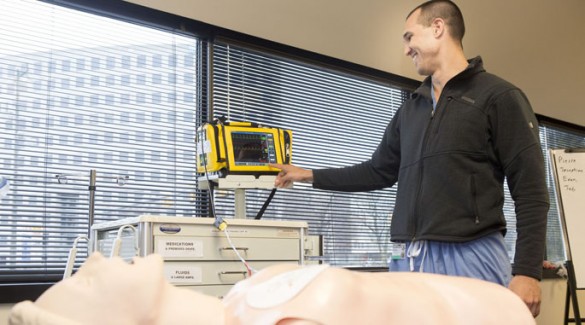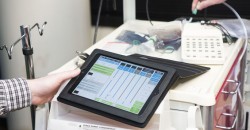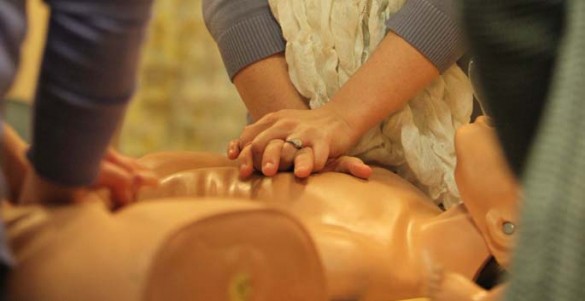
by Kathy Whitney and Sarah Carpenter
Vanderbilt University Medical Center’s resuscitation program is taking advantage of software technology to help teach lifesaving skills to health care providers who work in critical care.
While attending the EMS World Expo in January Jeff Hileman, manager of the resuscitation program, learned about an iPad app called iSimulate, a defibrillator and patient vital sign simulator that offers an innovative way to deliver high-quality life-saving training.
Critical care nurses, physicians and EMS providers are required to attend an advanced cardiac life support class (ACLS) every two years to keep their skills up to date.
Using the app, instructors program multiple real-life scenarios on one iPad while the students who are attending the ACLS class view them on a second iPad that fits into the iSimulate defibrillator bag. The bag contains the same equipment that a standard defibrillator does — wires for looking at rhythm, a blood pressure cuff, and all of the apparatuses that attach to patients.
“The defibrillators we’ve used for years only show cardiac rhythm and rate, and can’t be adjusted to allow for a dynamic learning experience,” Hileman said. “The iSimulate app shows temperature, invasive and non-invasive blood pressure, heart rate, respiratory rate and end tidal CO2. It adds an increase in fidelity and allows students to use critical thinking based on real time values.”
Pierre Massion, M.D., Ingram Professor of Cancer Research and director of the Thoracic Program at the Vanderbilt-Ingram Cancer Center, recently attended an ACLS class and found the technology to be helpful.
“The ACLS class was good as always, an important refresher on latest ACLS guidelines with clinically relevant scenarios. The great simulation allowed integration of all critically monitored variables including PETCO2 (capnography) for monitoring of quality chest compressions and return to spontaneous circulation,” said Massion, who works in the Division of Allergy Pulmonary and Critical Care Medicine.

After returning from the EMS World Expo, Hileman approached the Workforce Performance Operations (WPO) team with a request for iPads.
“Jeff came to us with a technology need that would allow for innovation in learning delivery. We were excited to enable his piloting period of the app and are excited by the great feedback the students are sharing,” said Anne Marie Danko, associate director of WPO.
ACLS instructor Epiphany Moore has enjoyed integrating the technology.
“It’s a great tool for demonstrating real-time vitals, compression artifact and the patient’s responses to interventions. The app enables the students and me to witness a patient’s presentation in a more realistic way,” she said.
“From what we’ve observed, instructors using the app are able to catch on quickly. You don’t need to be an iPad or app expert to successfully use it. It was important that ad-hoc instructors could easily put it to use,” Hileman said.
With the piloting period almost finished, Hileman looks forward to its more permanent implementation. In addition to ACLS, he’d like to see it added to the pediatric advanced life support (PALS) courses in the future. There are currently six scenarios used in training for ACLS and 18 for PALS.
“This app could be extremely effective for PALS training — its functionality includes video inputs and voice technology and that would really benefit the student experience,” Hileman said.
“We saw a need for more realism in our learning events and a lot of products on the market today are cool but very expensive. High fidelity mannequins can cost hundreds of thousands of dollars and are prone to mechanical problems and oftentimes require a biomedical staff to support them. The upkeep is tremendous. This simulator app creates an experience similar to that of a high fidelity mannequin without the cost.”















